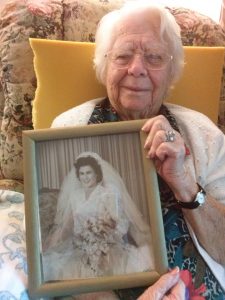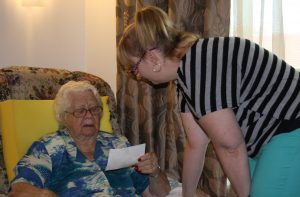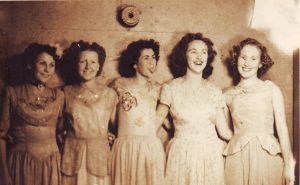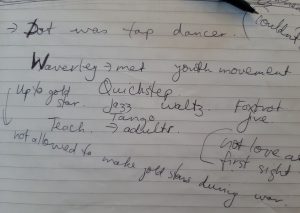9 minute read
This week’s blog is a lesson in how to start recording your family’s history, starting with one photograph at a time. My paternal grandfather Charlie died when I was 13 so I never got the chance to ask about his side of the family. But fortunately, some of his siblings lived to a grand old age, long enough for me to be mature enough to want to seek the answers out. I spent many hours with my Great Aunty Joyce who, by way of being the eldest girl in the family, was a wealth of information about her parents, grandparents and extended family. She even remembered her great aunt Charlotte, who had been born all the way back in 1847. By the time I got around to writing the Poulter book in the late 2000s, I was on a mission to record as many stories as I could from my great aunts and uncles. But the work did not stop there and even after the book was published, I would still ask questions at every opportunity. In 2013 and 2014, once my Great Aunty Mavis had moved into a nursing home in Sydney, I was able to visit and spend time with her. I didn’t see that much of her growing up, unlike my other great aunts and uncles, as she had a large family and rarely travelled to Dubbo like the others. So, I really started to get to know her at the end of her life. I do wish I had known her better earlier, as she was a totally cheeky and loveable character. In her little room at the nursing home, she had displayed many family photos, but the one of her on her wedding day really struck me. I asked if I could take a photo of her holding that photo. It’s now one of my most treasured photos as it shows what a life she had lived and the contrast between her younger self and her older self.

I will be featuring Aunty Mavis’ story at a later time, as I will all my other great aunts and uncles, so I won’t give too much away now. But clearly she was very proud of herself and the life she had carved out; married for 60-odd years and raising six children. Although on the outside she was now frail, that cheeky young girl was still within her and would pop out frequently as we spoke. And so it is that I have these wonderful photographs and memories of my visits to Aunty Mavis. She helped me find my place within her side of the family and connect with who they were, helping me to understand how my paternal side came to be. Here I am with aunty Mavis, asking about a particular photo of hers. This is a behind the scenes shot of me doing what I love best; connecting with loved ones and sharing a meaningful moment with them. In fact, it is sharing two meaningful moments; the act of encouraging her to remember this time in her life and the chance for us to bond over it.

Pulling out the old family photographs is my favourite way to start a conversation with a loved one. A photograph is a visual representation of a meaningful moment in time. Looking at an old photo of my own, I can be immediately transported back to that exact time; to what I was doing, how I was feeling and what was going on around me and in my life at the time. The old adage, ‘a picture paints a thousand words’ is indeed true; for an old photograph can conjure up not just memories, but feelings and thoughts. Some much can be captured from looking at just one photograph. They truly are a remarkable tool to capturing your family’s history.
So, let’s take an example of an old photograph and see what we can do with it. In the late 2000s, when I was writing the Poulter book, I visited my Aunty Mavis in her Central Coast home. We looked at some photographs and this one below struck me, as it had not only Mavis (in the middle), but her sister Beryl (left), Mavis’ bridesmaid Dot (second from left) and Mavis and Beryl’s sister in law Rose (far right) in it. The photograph was taken about 1948, in the years following straight on from WW2. It is also just a year or two before both Beryl and Mavis got married. It was an important time of freedom in these young women’s lives; in that space between leaving school, becoming independent and working and then settling down with a husband and a family.

I asked Aunty Mavis what was happening in the photo. She told me it was taken at a dance. The girls all loved to dance and have a good time. I scribbled some notes as she recounted the story behind the photo. Without these notes, I suspect I would not remember half of what she told me. What I did from here this week is turn those notes, handwritten over ten years ago, into a short story. I call it adding meat to the bones. And depending on how much time, effort and research you are willing to put into writing the story, you can end up with the 150 words or so I’ve used in the example below. Or an essay of two or three thousand words, which is what my blogs frequently turn into!

Here is the short story I would put next to this photo in an album, for example.
‘Aunty Mavis and Aunty Beryl were the last two children born in the Poulter family. They lived their teenage years in the shadow of WW2. This photo, taken in 1948 at a dance hall, shows just how much times had changed in the three years since the war had ended. The girls were now in their early 20s and loving their freedom. They pursued an active social life, attending dances two to three times a week, in between working, going to church on Sundays and responsibilities at home. Mavis was a particularly good dancer (if she did say so herself!) and had started to earn gold stars again by 1948, having been unable to during the war. Mavis’ talents encompassed various styles including Tango, Waltz, Foxtrot, Jive, Quickstep and Jazz. She had such a passion for dancing that she also taught other young men and women to dance. By 1949, Mavis had caught the eye of a tall young man called John, with whom she danced before eventually falling in love with him. They married in 1950 and had six children.’
If I wanted to add more, I would perhaps ask one of her children. I might try a place like Trove (online newspaper archive) to see if I could find any mention of her winning an award, or a story about dances of the 1940s. There are many ways to pad out a story and add interesting detail to it. You would not believe the types of things I have learnt about, just because an ancestor or loved one was involved in a particular pastime or occupation! (Like the time I found out that me, a vegetarian, was descended from a long line of pork butchers; what a hoot researching butchery was!)
So, what interesting old photographs do you have lying around, undocumented? I urge you to dig them out now! And start writing about the ones you have a story for. Write down the first things that come to your mind when you look at the photograph. Describe the scene; does it remind you of something you used to do or an emotion you were feeling at the time? Just get it down, write from your heart and then refine the story as you read back over it. If someone you know connected with that photograph is still alive, visit them or call them to ask about it. You may need to look through multiple photographs before you find one you can do this with. That doesn’t matter; there will be one eventually where you just feel compelled to write. Go searching now! Get out those old albums; grab a notebook or a piece of paper. Lay them side by side and slowly go through the photographs. Write when and where the feeling takes you. What you write doesn’t have to be perfect, it just has to exist.
Good luck!
